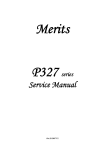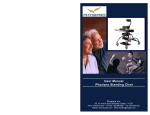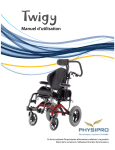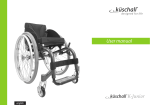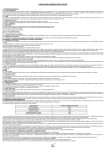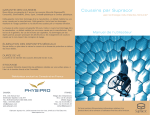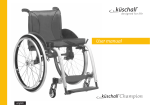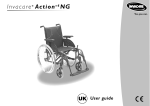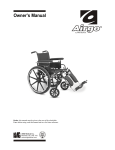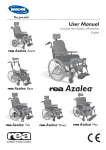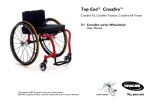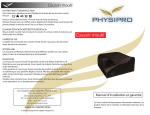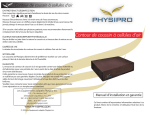Download User Manual
Transcript
Owners Manual This manual contains important informations about this product. Please pass it to the final user upon delivery. XL5 / XL5 CI wheelchair ENGLISH Physipro inc. is delighted to have you among its clients. We sincerely wish to thank you for the trust you have shown in our Company by choosing one of our products. This user manual has been designed to allow the client to use the XL5 / XL5 CI wheelchair, a Physipro inc. product, safely in an optimal way. For all adjustments and settings, Physipro inc. strongly recommends you consult a qualified professional. Physipro inc. provides you with specific verifications you should perform on a regular basis in order to optimize the performance of your XL5 / XL5 CI wheelchair and extend its operational life. Physipro inc. relieves itself from any liability should any bodily injury or property damage result from a lack of care or misuse or from any modification made to the product without prior written consent of the Company. For Physipro inc., your satisfaction remains a priority. 2 Owners manual ENGLISH Table of Contents 1. Components.................................................................................... 6 2. Specifications.................................................................................. 7 3. Recommendations........................................................................ 8 3.1 Safety Inspection Checklist............................................................... 8 3.2 Safety................................................................................................... 9 3.3 Cleaning, storage and recommendation....................................... 13 4. Adjusting Seat Depth................................................................. 14 5. Seat Height..................................................................................... 15 5.1 Front and Rear Wheels Combination.............................................. 15 5.2 Seat Height Adjustment.................................................................. 16 5.3 Front Casters Adjustment................................................................ 17 5.4 Caster Angle Adjustment................................................................. 17 6. Rear Wheels.................................................................................... 18 6.1 Installing Rear Wheels - Permanent Wheel Axle........................... 18 6.2 Installing Rear Wheels - Quick-Release Axle.................................. 19 6.3 Adjusting Quick Release Axle.......................................................... 19 6.4 Adjusting the Wheelbase forward and back.................................. 20 6.5 Rear Wheel Lateral Adjustment ...................................................... 21 7. Front Wheels.................................................................................. 22 7.1 Front Wheels Installation................................................................. 22 8. Backrest........................................................................................... 23 8.1 Back Angle Modification.................................................................. 23 8.2 Dynamic Backrest Installation ........................................................ 23 8.3 Backposts Height Modification....................................................... 26 8.4 Dynamic Backrest Option angle Modification....................................... 26 8.5 Dynamic Backrest Option Height Modification.................................... 26 8.6 Dynamic Backrest Option Stiffness Adjustment................................... 26 8.7 Folding Stabilizer Bar....................................................................... 27 8.8 Installation - Angle adjustable pushhandle (optional)................. 28 8.9 Angle adjustment of the pushhandle............................................. 29 3 Revision 5 December 2015 XL5 / XL5 CI wheelchair ENGLISH 9. Seat Canvas.................................................................................... 29 9.1 Adjustment....................................................................................... 29 10. Armrests........................................................................................ 30 10.1 Armrests Type “U” ........................................................................ 30 10.1.1 Flipping Armrest Back................................................................ 30 10.1.2 Armrest Height Adjustment....................................................... 30 10.2 Armrests Type “T” ......................................................................... 30 10.2.1 Removing Armrest...................................................................... 30 10.2.2 Armrest Height Adjustment....................................................... 30 10.3 Armrests Type “L”.......................................................................... 31 10.3.1 Flipping Armrest Back................................................................ 31 10.3.2 Armrest Height Adjustment....................................................... 31 11. Footrests....................................................................................... 32 11.1 Swing-in/swing-out Footrests....................................................... 32 11.2 Height Adjustment......................................................................... 32 11.3 Angle and Depth Adjustable Footplates (optional).................... 33 11.4 Footplate Vertical Adjustment...................................................... 33 11.5 Folding Footplate .......................................................................... 34 12. Articulated Legrest................................................................... 35 12.1 Installation...................................................................................... 35 12.2 Height Adjustment......................................................................... 36 12.3 Angle Adjustment.......................................................................... 36 13. Brakes ........................................................................................... 37 13.1 Push to lock brake.......................................................................... 37 13.1.1 To Apply Brakes........................................................................... 37 13.2 Pull to lock brake........................................................................... 38 13.2.1 Brakes adjustment..................................................................... 38 13.2.2 To Apply Brakes........................................................................... 38 4 Owners manual ENGLISH 14. Anti-Tip Tubes............................................................................ 39 14.1 Inserting Anti-tippers In Receiver................................................. 39 14.2 Adjustment..................................................................................... 39 14.3 Remove the anti-tippers................................................................ 39 15. Seat Positioning Strap............................................................. 40 15.1 Seat Positioning Strap .................................................................. 40 16. Folding/Unfolding the Wheelchair.................................... 40 16.1 Folding Wheelchair ....................................................................... 40 16.2 Unfolding the Wheelchair............................................................. 41 16.3 Folding Backrest (Optional).......................................................... 42 16.4 Transit use ..................................................................................... 42 Appendix A Seat-to-floor Height .............................................. 43 Appendix B XL5 and XL5ci Wheelchair Depth Chart.......... 47 Appendix C Pediatric Configuration Restrictions................ 47 Maintenance Guide......................................................................... 48 Warranty.............................................................................................. 50 5 Revision 5 December 2015 XL5 / XL5 CI wheelchair ENGLISH 1. Components The main components are provided with the standard model. Several options and accessories are also available. Please contact us for more details or refer to the purchase order. Frame Wheel lock Padded SwingAway Armrest Push handle Seat Backrest Swing-Away Latch Release Rear wheel QuickRelease Axle Swing-In / Swing-Out Legrest Handrim Anti-Tip Tube Flip-up Footplate Front wheel Caster Fork Figure 1 : Wheelchair Main Components 6 Owners manual 2. Specifications Standard model ENGLISH Standard model CI model CI model Table 1 : XL5 / XL5 CI Wheelchair Specifications Frame Type Folding Frame Material Aluminum A Backrest Height Standard : 12" to 25" B Seat Depth Adult : 14" to 22" (14" and 15" will not be adjustable 1" less) Pediatric : 12" to 16" C Seat Width Adult : 12" to 24" Pediatric : 12" to 16" D Seat-to-floor Height Standard model: CI model: Back height: 13" to 20 ½" Front height: 13" to 21" Back height: 11 ½" to 19" Front height: 11 ½" to 19 ½" E Overall Length Measurement include the footrest. (24" seat depth available in option) F Overall Width Seating Width + 8" G Rear Wheel Diameter 20" , 22", 24" or 26" H Front Wheel Diameter 4" , 5" , 6" , 7" or 8" I Transport Weight* XL5 Standard: 32.2 lb CI Model: 27.6 lb Pediatric : 31.2 lb J Weight Limit Standard 250 lb Heavy Duty 350 lb CI : 13" to 26" Pediatric : 12" to 20" Pediatric : 165 lb Adjustable backrest angle range 85° to 115° (Push Handle Straight or 8°) Standard Armrest : - « U » type 7" to 12" - « U » type lowered from 6" to 9" - « L » type 8" to 10" CI Armrest : - « U » type 8" to 13" - « U » type lowered from 6" to 9" - « L » type 9" to 11" Footrest : 60° - 70° - 90° Legrest : Elevating/Articulating legrest 14" to 19" *Weight based on 16” x 16” wheelchair with all standard components except for rear wheels. Rear wheels are excluded since there are multiple different weights for possible wheel configurations. Example, a pair of standard 22" rear wheels weighs 7.8 lb. 7 Revision 5 December 2015 XL5 / XL5 CI wheelchair ENGLISH Physipro inc. offers several accessories and options to help you customize your wheelchair according to your specific needs. Please contact us for more details or refer to the purchase order. Do not use this equipment without having read and understood this user manual in its entirety. This manual includes critical information intended to ensure the safety of the user and the individuals who handle the XL5 / XL5 CI wheelchair. 3. Recommendations 3.1 Safety Inspection Checklist Maintenance procedures: Ensure that the wheelchair rolls straight and that all parts work smoothly. Check for noise, vibration, or a change in ease of use. Make sure that the wheel locks do not interfere with tires when rolling. Verify that the wheel locks are easy to engage. Make sure the anti-tip tubes lock in place. Ensure that the wheel locks prevent the wheelchair from moving when engaged. Ensure the seat and backrest are stable and secured to the frame; Inspect the seat and backrest for loose or broken hardware. Check for proper tire inflation pressure; Inspect tires for flat spots and wear. Ensure armrests are secured when locked; Check if footrests are positioned and secured properly; Ensure there is no heavy object fixed to the backrest; Ensure the seat positioning strap is secured to the frame and adjusted to the client’s needs. Check to see that both quick-release rear axles are locked. 8 Owners manual ENGLISH 3.2 Safety Several safety measures must be applied to ensure the safety of the user and the individuals who handle or use the wheelchair. Note that the following list is not exhaustive. Therefore, the user and the individuals who handle or use the wheelchair have the responsibility to handle it or use it cautiously. Never use the wheelchair with improper tire inflation pressure; Never attempt to reach an object if you have to lean forward, backward or sideways; Do not attempt to approach an obstacle whose height could reduce the stability of the wheelchair; Never carry passengers; Do not fasten objects to the backrest, except those provided with the wheelchair; Do not attempt to tilt the wheelchair without any assistance; Never use the footplate as a platform. When getting in or out of the wheelchair, make sure that the footplates are in the upward position. Do not stand on the frame of the wheelchair. Do not expose the wheelchair directly to the sun, the hot surfaces could cause severe burns; Always keep fingers and hands clear of any moving parts; Use the provided anchorage rings for specialized transportation. These anchorage rings do not substitute for the restraining system certified by Transport Canada. 9 Revision 5 December 2015 XL5 / XL5 CI wheelchair ENGLISH Steps 1. Unlock and rotate the anti-tip tubes up in order to avoid conflict with the stairs. 2. The assistant should grab both push handles and position the wheelchair on the top step and tilt it in order to lift the front wheels. 3. The assistant must maintain this position and push cautiously forward until the front wheels of the wheelchair touch the ground. Figure 2 : Steps Note - Never try to descend a step without assistance. Going up and down stairs The intervention of two assistants is required to go up or down stairs. To do so, one assistant should stand behind the wheelchair holding the push handles. The second assistant should maintain a fixed part of the frame at the front of the wheelchair to prevent it from rolling forward. Going down slopes It is very important to control your direction and your speed when going down slopes. To make a safe descent, lean back and let the handrims slide slowly in your hands. You should always be able to stop the wheelchair by blocking the handrims. Figure 3 : Going up and down stairs Note- Always have an assistant behind the wheelchair when going down long slopes. Figure 4 : Going down slopes 10 Owners manual ENGLISH Going up slopes Lean your body forward and propel evenly with both hands. WARNING When on a slope, the center of balance of your wheelchair may be affected. Your wheelchair could tip backwards, forwards or sideways and anti-tip tubes may not prevent a fall or tip-over. Your wheelchair is less stable when riding on a slope. Transfer Before attempting to transfer, every precaution should be taken to minimize the gap distance. 1. Turn the front wheels parallel to the target object you are transferring. 2. Make sure the wheel locks are engaged to avoid the chair moving. 3. Remove or swing-away the armrest 4. Remove or swing-away the legrest Figure 5 : Going up slopes Note – Use a transfer board if at all possible. WARNING It is not recommended to transfer without the help of an assistant; it requires good Figure 6 : Transfer balance and agility. Be warned that there is a time during the transfer when the wheelchair is not below you. Lifting DO NOT attempt to lift the wheelchair by any removable parts. Lifting the wheelchair by its removable parts may result in injury or damage to the wheelchair. 11 Revision 5 December 2015 XL5 / XL5 CI wheelchair ENGLISH Exterior Use • At night, use reflective tape on your chair and clothing. • Do not cross a road with dense fast-moving traffic of more than two lanes. • Make eye contact with drivers before you go forward when you cross a street. • Be extremely careful when you use your wheelchair on a wet or slick surface. In case of any doubt do not hesitate to ask for help. • Avoid excess moisture Weight Limitation NEVER exceed the weight limit for combined weight of user and items carried. Exceeding the weight limit may result in injury or damage to your chair, a fall, tip-over or loss of control. (For weight limit, please refer to table 1, page 6) Terrain Do not use your wheelchair on sand or gravel surface soils. This may damage wheels or axles or loosen fasteners of your chair. Seat Positioning Strap Always wear your seat positioning strap. The seat positioning strap is an option on this chair. You may order without the seat positioning strap. To ensure an additional safeguard, Physipro strongly recommends ordering the seat positioning strap. However, the seat positioning strap has a primary purpose of positioning. It is not designed for use as a safety device withstanding high stress loads such as auto or aircraft safety belts. Immediately replace the strap If signs of wear appear. Serious injury can occur in the event of a fall from a wheelchair. WARNING The anti-tippers are not to be used as tipping levers. 12 Owners manual ENGLISH Tires Ensure your wheelchair has the proper tire pressure before using it. Proper pressure extends the life of your tires and facilitates its use. The recommended tire pressure is listed on the tire. • Do not overinflate the tires. • Do not use your wheelchair if the tires are under or over-inflated • Low air pressure may make the wheel lock slip and allow the wheel to turn unexpectedly. • Over-inflated tires may burst. Failure to follow these suggestions may result in serious bodily injury to the user and damage to the wheelchair. 3.3 Cleaning, Recommendations and Storage 3.3.1 Paint : Cleaning your wheelchair with mild soap or a diluted neutral desinfectant (2 ounces for 8 liters of water) is recommended at least once a month. To protect the paint, we suggest that you put a coat of non-abrasive car wax every 3 months. 3.3.2 Recommendations : Remove any filth (organic and / or biological) immediately. Do not flush with water (the tubing and others parts could corrode from the inside). If so, dry as soon as possible. You can dry clean your wheelchair with the proper equipment. If the user is contagious, disinfect the seat, the armrests, the backrests and every other surface daily with a disinfectant. Do not rinse or wipe, just let it dry. 3.3.3 Storage : Store your chair in a clean, dry area. If stored for more than 3 months, have your chair inspected by an authorized dealer before use. 13 Revision 5 December 2015 XL5 / XL5 CI wheelchair ENGLISH 4. Adjusting Seat Depth Please refer to Appendix B for additional details on the seat depths. Follow these steps to modify the depth : 1. Using two 10 mm wrenches, unscrew screws A and B; 2. Move the backposts 1" backward or forward to get the desired depth. 3. Replace screws and covers A and B, tighten. 4. If you reduce the depth, you will have to take off the tube extensions, otherwise you will have to move them. Read the following sections. A B Figure 7 : Seat Depth Modification Once the desired depth is reached, adjust the tube extensions. Follow these instructions : 1. Unscrew screw C with a Philips screw driver. 2. Push, pull or remove the tube extension D to reach the actual depth. 3. Replace screw C, tighten. C D Figure 8: Adjustment of the Tube Extensions Figure 9 : Positions for the tube’s extensions 14 Owners manual ENGLISH 5. Seat Height These two characteristics will define the seat height on the wheelchair XL5 / XL5 CI : B A Figure 10 : Seat Height The combination of the front and rear wheels’ size; The position of the rear wheels anchoring mechanism. 5.1 Front and Rear Wheels Combination The combination of the front and rear wheels’ size will define the seat height as presented in Figure 10. If a wheel modification is needed, refer to section 6.1 or 7.1 for the installation. 15 Revision 5 December 2015 XL5 / XL5 CI wheelchair ENGLISH 5.2 Seat Height Adjustment Using the Rear Wheels Anchoring Mechanism When a modification of the rear wheels is done on the anchoring mechanism, it could be necessary to change the size or position of the front wheels. Refer to section 5.3. Please refer to seat height tables in section 17. Seat height adjustment using the rear wheels anchoring mechanism : 1. 2. 3. 4. 5. 6. Remove the rear wheel with the quick release push-button, refer to section 6.1. Using two 10 mm wrenches, unscrew screws A Adjust anchoring mechanism to the desired position. Replace screws A, tighten. Reinstall the rear wheels. If necessary, modify the front wheel’s position or size. A A A A Figure 11 : Seat Height Modification Warning After any adjustments, make sure all attaching hardware is tightened securely - otherwise injury or damage may occur. Warning Ensure both front casters are the same size and are installed into the same respective mounting hole before using the wheelchair - otherwise injury or damage may occur. 16 Owners manual ENGLISH 5.3 Front Casters Adjustment Four-hole caster forks allow a seat height adjustment. Follow these steps : 1. Unscrew screw A with two 13 mm wrenches 2. Position the wheel in one of the preset holes when the desired height is reached. 3. Reinstall according to section 7.1 instruction. Note - Once installed, the wheel should turn easily. A Figure 12 : Changing the front wheels’ position 5.4 Caster Angle Adjustment To allow easier propulsion, the caster housing should always be at a 90º angle to the floor (perpendicular to the ground). 1. With a 10mm wrench, untighten screws A and B as much as possible. 2. Rotate the special hexagonal nuts C and D so that the fork E has a 90º angle with the floor. 3. When the alignment is correct, retighten screws A and B. 4. Repeat the process for the other caster C A E D B Figure 13 : Square the Front Forks 17 Revision 5 December 2015 XL5 / XL5 CI wheelchair ENGLISH 6. Rear Wheels 6.1 Installing Rear Wheels - Permanent Wheel Axle Figure 14 : Installing Rear Wheels - Permanent Wheel Axle 1. Make sure the positioning device E is inserted in plate F including locking device G; 2. Secure it firmly in place with the lock washer D and H and nut C and I ; 3. Insert axle A in the positioning device E with the wheel hub B; 4. Tighten nut J with a 3/4" monkey wrench while holding axle A with a 3/4" socket wrench. The size/position of the front casters, the position of the brakes as well as the anti-tippers directly relate to the stability of the wheelchair. Any change to the rear wheel size/position may cause the wheelchair to decrease in stability. Please refer to section 6.4 to perform the necessary adjustments. These adjustments MUST be performed by a qualified technician. Verify systematically the stability of the wheelchair. It might be necessary to change the horizontal position of the rear wheel. Refer to section 6.4. 18 Owners manual ENGLISH 6.2 Installing Rear Wheels - Quick-Release Axle Figure 15 : Installing Rear Wheels - Quick-Release Axle 1. Make sure the positioning device E is inserted in plate F including locking device G; 2. Secure it firmly in place with the lock washer D and H and nut C and I ; 3. Insert axle A in the positioning device E with the wheel hub B. 6.3 Adjusting Quick Release Axle The balk A must exceed the positioning device B and be completely output to hold the wheel assembly. Tighten or loosen nut C with a 3/4" wrench and a 7/16" wrench. Make sure the detent pin and detent balls of the quick release axle are fully release before operating the wheelchair. The detent balls MUST be protruding past the inside of the rear wheel axle bushing for a positive lock. Check that quick-release axles lock properly. Lubricate if necessary. Keep quick-release axles free of dirt and lint to ensure positive locking and proper operation. 19 Revision 5 December 2015 XL5 / XL5 CI wheelchair ENGLISH 6.4 Adjusting the Wheelbase forward and back The rear wheels position is very important for the base stability. The XL5 / XL5 CI wheelchair offers 13 different positions front to back. Please follow these steps : 1. Remove the rear wheel refer to section 6.1 or 6.2 2. Unscrew nut A with a 1 1/8" wrench to free washers B and C. 3. Slip positioning mechanism D in the slot of the anchoring plate and install washer C at the desired position. 4. Put back nut A with a 1 1/8" wrench, tighten. 5. Reinstall the rear wheel. C A D B Exterior View Interior View (with Quick Release axle) Foremost Position of the Wheel Rearmost Position of the Wheel Figure 16 : Adjusting the wheelbase width 20 Owners manual ENGLISH 6.5 Rear Wheel Lateral Adjustment This modification is used to move the rear wheels closer or further from the frame. To do so, follow these instructions : 1. Remove the rear wheels, refer to section 6.1 2. Untighten nut A and B to release the positioning device C with the use of a 1 1/8" wrench. 3. Unscrew or screw nut A and B to move the positioning device in or out. 4. Tighten nut A and B with the 1 1/8" wrench. 5. Reinstall the rear wheel. B A Innermost Position of the Wheel C Outermost Position of the Wheel Figure 17 : Rear wheel Lateral Adjustement After any adjustments, make sure all attaching hardware is tightened securely – otherwise injury or damage may occur. 21 Revision 5 December 2015 XL5 / XL5 CI wheelchair ENGLISH 7. Front Wheels 7.1 Front Wheels Installation To change the wheels, simply follow these instructions: 1. Determine the front wheel position on the fork. Refer to Appendix A. 2. Insert screw A in the corresponding hole with both spacers B between the wheel and fork on each side. 3. Put bolt C at the end of screw A and tighten with two 13 mm wrenches. *Note - Once tightened, the wheel must turn easily A C B B Figure 18 : Front Wheels Installation This step is required when a change to the front wheels’ position or seat height has been made. It will help to always have a straight line, to allow easier propulsion. Please refer to section 5.4 22 Owners manual ENGLISH 8. Backrest 8.1 Back Angle Modification The XL5 / XL5 CI wheelchair back angle can be adjusted to satisfy your client’s needs. To do so, follow these instructions: 1. Unscrew screw A with two 10 mm wrenches 2. Once the screw has been removed, modify the angle to meet your client’s needs. 3. When the desired angle is reached put the screw A in one of the preset holes. 4. Tighten A Figure 19 : Back Angle Modification Note: There is a 5º angle between every hole position. 8.2 Dynamic Backrest Installation Follow these instructions to replace a standard back by a dynamic back: 1. Remove the armrests and the wheels; 2. Remove the backrest ; 3. Unscrew bolt A to remove the back posts; A Figure 20: Dynamic Backrest Installation 23 Revision 5 December 2015 XL5 / XL5 CI wheelchair ENGLISH 1. 2. 3. 4. 5. 6. Remove the armrests and the wheels; Remove the backrest ; Unscrew bolt A to remove the back posts; Remove the armrest hardware B, screw C and screw H on the small tube; Remove bolt D; Using a flat punch remove sleeves E to release the plate. ; H D C D B E Figure 21: Dynamic Backrest Installation 24 Owners manual ENGLISH 7. Install the bottom part of the dynamic back post by re-inserting the two sleeves E; 8. Re-install bolts J and armrest hardware; 9. Re-install back post and backrest; 10. Replace armrest and rear wheels. J Figure 22: Dynamic Backrest Installation Figure 23: Dynamic Backrest Installation 25 Revision 5 December 2015 XL5 / XL5 CI wheelchair ENGLISH 8.3 Backposts Height Modification The XL5 / XL5 CI wheelchair offers 3 different sizes of adjustable and swingaway backposts: They can be ajustable by 12" to 15", 16" to 20" or 21" to 25". To modify the height, follow these steps: 1. Remove screw A with a 10 mm wrench. 2. To get the desired height, pull the backposts up or down as needed. 3. Replace screw A, tighten. A Figure 24 : Backposts Height Modification 8.4 Dynamic Backrest Option Angle Modification Same as 8.1. 8.5 Dynamic Backrest Option Height Modification Same as 8.2 8.6 Dynamic Backrest Option Stiffness Adjustment 1. 2. 3. 4. Adjust the desired tension using handle A. Screw (clockwise) for a stiffer response. Unscrew (counter clockwise) for a softer response. Make sure to adjust both sides as desired. A Figure 25: Dynamic Backrest option Stiffness Adjustment 26 Owners manual ENGLISH 8.7 Folding Stabilizer Bar 8.7.1 Installation 1. Cut both ends of the rubber handle. 2. Insert the aluminum spacers A at the end of each handle. 3. With a 4 mm Allen key, tighten screw B. 8.7.2 Folding 1. Press push-button C. 2. Rotate handle D to keep button C depressed. 3. Press push-button E. 4. Slide handle D right or left. D B A E Opened position C Figure 26 : Folding Stabilizer Bar Installation 27 Revision 5 December 2015 XL5 / XL5 CI wheelchair ENGLISH 8.8 Installation - Angle adjustable pushhandle (optional) To install the pushhandle please follow these instructions: 1. Cut the extremities of the coating using a utility knife; 2. Using a 5 mm allen key insert bolt B in the connecting piece A to install it into the back tube receiver; 3. Install the pushhandle into the connecting piece and screw bolt C Using a 3 mm allen key and a 8 mm closed-end wrench. 4. Once adjusted and inserted, tighten locking screws D to lock tube E. Figure 27: Installation Angle adjustable pushhandle 28 Owners manual ENGLISH 8.9 Angle adjustment of the pushhandles 1. Depress both push buttons A simultaneously. This will allow the handles to rotate freely. Once the desired position is achieved, release push buttons A and the handles will lock. Figure 28: Angle adjustable pushhandle 9. Seat Canvas 9.1Adjustment To adjust the canvas, undo the velcro underneath and pull to straighten. When straightening the canvas, make sure the seat rails are anchored properly. 29 Revision 5 December 2015 XL5 / XL5 CI wheelchair ENGLISH 10. Armrests 10.1 Armrests Type “U” 10.1.1 Flipping Armrest Back 1. Depress the release latch A. 2. Pull the armrest toward back of wheelchair 10.1.2 Armrest Height Adjustment 1. Push the release latch B. 2. Slide armpad C up or down to the desired height. 3. When the desired height is reached, release latch B making sure the armrest is properly anchored in the right adjustment hole. C A B Figure 29 : Type “U” Armrest 10.2 Armrests Type “T” 10.2.1 Removing armrest 1. Push the release latch A. 2. To remove, pull up on armrest B. 10.2.2 Armrest height Adjustment 3. Press on button C. 4. Slide armpad B up or down to the desired height. 5. When the desired height is reached, release press-button C making sure the armrest is properly anchored in the right adjustment hole. B C A Figure 30 : Type “T” Armrest 30 Owners manual ENGLISH 10.3 Armrests Type “L” 10.3.1 Flipping Armrest Back 1. Pull the armrest towards the back of wheelchair Armrest Height Adjustment Remove screw A with a 10 mm wrench. Pull up or down on the armrest. When the desired height is reached, put back screw A in the right hole 4. Tighten. 10.3.2 1. 2. 3. A Figure 31: Type “L” Armrest After any adjustments, make sure all attaching hardware is tightened securely - otherwise injury or damage may occur. Never operate or replace flip-back armrest when wheelchair is folded otherwise injury or damage may result. Make sure the armrest is securely locked into arm socket and armrest release button locks into place before using. Always lift the wheelchair by gripping the frame. Never lift the wheelchair by the removable armrests or the footrests. 31 Revision 5 December 2015 XL5 / XL5 CI wheelchair ENGLISH 11. Footrests 11.1 Swing-in/swing-out Footrests 1. Place the footrest into the receiver on front frame tube with the footrest facing outward from the frame. 2. Rotate the footrest inward until it locks into place on locking bolt. 3. To swing-out, press handle A to unlock the footrest and rotate outward. A Figure 32: Swing-out Footrests 11.2 Height Adjustment 1. Remove screw A using a 10 mm wrench. 2. Slide footrest extension up or down inside the frame tube to the desired height. 3. Replace screw A, tighten. A Figure 33: Footrest Height Adjustment 32 Owners manual ENGLISH 11.3 Angle and Depth Adjustable Footplates (optional) Angle Adjustment 1. With a 5 mm Allen key, loosen screw A 2. Turn the footplate around the footrest mechanism to adjust the footplate to desired angular position. 3. Re-tighten once the adjustment is done. Depth Adjustment 1. With a 5 mm Allen key, loosen screw A 2. For a depth adjustment, slide forward or backward the footrest on its rail. 3. Re-tighten once the adjustment is done. A Figure 34: Footplates Adjustment 11.4 Footplate Vertical Adjustment Only available with the angle and depth adjustable footplates 1. Position the Allen Key, at the opposite of the anchor block. 2. With a ¼” Allen key screw or unscrew the vertical adjustable screw A under the footplate. Note - Screw the vertical adjustable screw A to decrease the angle B and unscrew the screw A to increase the angle B. A B Figure 35: Footplate Vertical Adjustment 33 Revision 5 December 2015 XL5 / XL5 CI wheelchair ENGLISH 11.5 Folding Footplate To fold, simply pivot footplate upward to vertical position. Figure 36: Footrest Folding Do not lift the wheelchair using its footrests to avoid injuries or damages to your wheelchair. Use the rigid parts of the frame. 34 Owners manual ENGLISH 12. Articulated Legrest 12.1 Installation of the articulated legrest 1. Place the legrest into the receiver on front frame tube with the legrest facing outward from the frame; 2. Rotate the legrest inward until it locks into place on locking bolt; 3. To remove that leg rest, press push button A, rotate the articulated legrest outward and lift. Figure 37: Installation of the articulated legrest 35 Revision 5 December 2015 XL5 / XL5 CI wheelchair ENGLISH 12.2 Height adjustment 1. Remove screw B using a 10 mm wrench; 2. Slide footrest extension up or down inside the frame tube to the desired height; 3. Replace screw A, tighten. Figure 38 : Articulated Legrest Height Adjustment 12.3 Angle adjustment 1. To raise legrest, hold the lower part of the footrest while pulling it up ; 2. To lower the leg angle, press the lever C while holding the user’s leg to the desired angle. Figure 39 : Articulating Legrest Angle Adjustment 36 Owners manual ENGLISH 13. Brakes 13.1 Push to lock brakes 1. Loosen screw A using a 3/16" wrench; 2. As needed, move the slider bar of brake B forward or backward; 3. Tighten screw A. B A Figure 40 : Adjustment and Applying Brakes 13.1.1 To Apply Brakes 1. Push the handle forward to apply the brakes; 2. Pull the handle backward to release the brakes. Never stop a moving wheelchair with wheel locks. Wheel locks are not brakes. When breaks are applied, the breaking stop must sink into the tire by 1/8" to ¼". It is important to adjust the brakes if a modifications of the rear wheels are done or if the tires are wore out. 37 Revision 5 December 2015 XL5 / XL5 CI wheelchair ENGLISH 13.2 Pull to lock Brakes 13.2.1 Brakes adjustment 1. Loosen screw A using a 10mm wrench or ratchet; 2. As needed, move the brake assembly B forward or backward; 3. Tighten screw A. A B Figure 41 : Adjustment and Applying Brakes 13.2.2 To apply brakes 1. Pull the handle C backward to apply the brake; 2. Push the handle C forward to release the brake. 38 C Owners manual ENGLISH 14. Anti-Tip Tubes 14.1 Inserting Anti-tippers In Receiver 1. Press the rear anti-tipper release pin A on the anti-tipper tube so that both release pins are drawn inside. Insert into the anti-tipper receiver. 2. Slide the anti-tipper until release pin is positioned through the lower receiver mounting hole. 3. Repeat the process with the second anti-tip tube. A B Figure 42 : Anti-Tip Tubes 14.2 Adjustment Once the anti-tipper is installed, you must adjust its height to the proper setting. To do so, press anti-tipper release pin B and raise or lower the moving part of the anti-tipper. 14.3 Remove the anti-tippers To remove the anti-tippers, simply press on the release pin B and pull the antitipper. Make sure the anti-tippers are fully engaged and release buttons fully protruding out of adjustment holes. Anti-tippers must always be used. When outdoors on wet, soft ground or on gravel surfaces, anti tippers may not provide the same level of protection against tipover. Ensure both anti-tippers are adjusted to the same mounting hole. Physipro recommends anti-tippers for all wheelchairs Always verify if the anti-tippers are at a proper height after making any adjustments or modifications to the wheelchair in order to ensure the safety of the user. For maximum safety, the distance between the ground and the antitipper must not exceed 2". The anti-tippers are not to be used as tipping levers. 39 Revision 5 December 2015 XL5 / XL5 CI wheelchair ENGLISH 15. Seat Positioning Strap 15.1 Seat Positioning Strap It’s very important to adjust the seat positioning strap properly to maximize comfort and safety. To adjust the length of the strap, you must slide the strap A into the plastic buckle B in order to lengthen or shorten the belt. A B Figure 43: Seat Positioning Strap 16. Folding/Unfolding the Wheelchair 16.1 Folding the Wheelchair 1. 2. 3. 4. Swing legrest/footrest in locked position to the front of the wheelchair. Pivot footplates upward to vertical position. Remove the seat cushion. Pull the handle of the seat upholstery and lift up. Figure 44 : To Fold the Wheelchair 40 Owners manual ENGLISH 16.2 Unfolding the Wheelchair 1. Place your hand on the top of the seat rail 2. Ensure your fingers and thumbs are pointed inside of the wheelchair 3. Press downward on the top of the seat rail until the wheelchair is fully open and the seat rails fully seated. 4. Install Stabilizer Bar. Refer to installing the stabilizer bar in section 8.6 if installed. 5. Reinstall all postural components Note: Ensure that the footrest is locked prior to use Figure 45 : To Unfold the Wheelchair Make sure your thumb and fingers point to the inside of the wheelchair. Never wrap your thumb or fingers under the seat rail. Make sure the wheelchair is completely unfolded and the seat rails are anchored properly berfore using the wheelchair. 41 Revision 5 December 2015 XL5 / XL5 CI wheelchair ENGLISH 16.3 Folding Backrest (Optional) This option allows you to completely fold the backrest of the manual wheelchair. This operation facilitates transportation. To do so, lift lever A and push the push handles forward. 16.4 Transit use The wheelchair is equipped with securement points which are used to provide increased stability during transportation. The figure below shows the locations of the wheelchair’s securement points. Two anchorage rings in the back A Figure 46: Folding the Back Two anchorage rings in the front Figure 47: Transit use If the wheelchair is used for transport, it must be used in a forward-facing seating position. Only use the provided securement points during transportation. Never fix any anchor cable on any other part of the wheelchair. Furthermore, you have to install the cables as recommended by Transport Canada for maximum security. The anchorage rings of the wheelchair do not substitute for the restraining system certified by Transport Canada. PHYSIPRO is not responsible for the risks undertaken when using the wheelchair as a seat in public or private transportation. Failure to follow these warnings may cause damage to your chair, a fall, tip-over or loss of control and cause severe injury to the rider or others. 42 Owners manual ENGLISH Appendix A - Seat-to-floor Height XL5 standard model including pediatric format (26 inches not available in pediatric format) Wheels positioning 1. Define the height difference between the front and rear of the wheelchair according to the desired seat angle. 2. Select the configurations of the front and rear wheels in accordance with the height difference previously obtained (by increment of ± ½"). Rear Floor to Seat Height Chart Rear Wheel Diameter XL5 POSITION A B C D E F G H I J 20" 13 13 ½ 14 14 ½ 15 15 ½ 16 16 ½ 17 17 ½ 22" 14 14 ½ 15 15 ½ 16 16 ½ 17 17 ½ 18 18 ½ 24" 15 15 ½ 16 16 ½ 17 17 ½ 18 18 ½ 19 19 ½ Rear Wheel Diameter XL5 ci 26" 16 16 ½ 17 17 ½ 18 18 ½ 19 19 ½ 20 20 ½ POSITION A B C D E F G H I J 20" 11 ½ 12 12 ½ 13 13 ½ 14 14 ½ 15 15 ½ 16 22" 12 ½ 13 13 ½ 14 14 ½ 15 15 ½ 16 16 ½ 17 24" 13 ½ 14 14 ½ 15 15 ½ 16 16 ½ 17 17 ½ 18 26" 14 ½ 15 15 ½ 16 16 ½ 17 17 ½ 18 18 ½ 19 Note - The measures are for reference purposes only. They depend on the wheel diameter, tilt angle and the rear wheel axle location. Figure 48: Rear seat height 43 Revision 5 December 2015 XL5 / XL5 CI wheelchair ENGLISH Front Seat to Floor Height XL5 Standard Frame - Short Fork POSITION A B C D Front wheel diameter 4" 5" 6" 7" 8" 15 15 ½ 15 ½ 16 16 ½ 16 16 ½ 17 17 ½ 16 ½ 17 17 ½ 18 18 ½ XL5 ci Standard Frame - Short Fork POSITION A B C D Front wheel diameter 4" 5" 6" 7" 8" 13 ½ 14 14 14 ½ 15 14 ½ 15 15 ½ 16 15 15 ½ 16 16 ½ 17 A B C D Figure 49: Short fork - standard frame XL5 Standard Frame - Long Fork POSITION A B C D Front wheel diameter 4" 5" 6" 7" 8" 17 ½ 18 18 ½ 19 19 ½ 18 18 ½ 19 19 ½ 20 18 ½ 19 19 ½ 20 20 ½ 19 19 ½ 20 20 ½ 21 XL5 ci Standard Frame - Long Fork POSITION A B C D Front wheel diameter 4" 5" 6" 7" 8" 16 16 ½ 17 17 ½ 18 16 ½ 17 17 ½ 18 18 ½ 17 17 ½ 18 18 ½ 19 17 ½ 18 18 ½ 19 19 ½ B A C D Figure 50: Long fork - standard frame 44 Owners manual ENGLISH XL5 Hemi Frame - Short Fork POSITION A B C D Front wheel diameter 4" 5" 6" 7" 8" 15 15 ½ 15 ½ 13 13 ½ 13 13 ½ 14 14 ½ 13 ½ 14 14 ½ 15 15 ½ XL5 ci Hemi Frame - Short Fork POSITION A B C D Front wheel diameter 4" 5" 6" 7" 8" 15 15 ½ 15 ½ 11 ½ 12 11 ½ 12 12 ½ 13 12 12 ½ 13 13 ½ 14 A B C D Figure 51: Short fork - Hemi frame 45 Revision 5 December 2015 XL5 / XL5 CI wheelchair ENGLISH Height Difference vs Angle Height difference 0° 3° Angle 6° 9° 12° 15° 0" 1" 2" 4" 5" 3" A : Front floor to seat height B : Back floor to seat height B A Figure 52 : height difference Note – The height difference value is to be used as a guide for reference purposes only. It can vary according to the wheel positions and frame type. The tilt degrees listed in the table above were determined according to a depth of 16". The angle of tip of the XL5 / XL5 CI wheelchair must not exceed 15°. A greater angle could reduce the stability of the wheelchair. The front seat height must be equal to or greater than the rear seat height. Use alcohol-free or soft detergents to clean. Do not use strong detergents or diluents. 46 Owners manual ENGLISH Appendix B - XL5 AND XL5ci WHEELCHAIR DEPTH CHART FOLDING FRAME Standard Double FRONT FRAME SELECTED DEPTH POSSIBLE ADJUSTMENT SELECTED DEPTH POSSIBLE ADJUSTMENT PEDIATRIC PEDIATRIC MINI SHORT SHORT SHORT MEDIUM MEDIUM MEDIUM LONG LONG LONG 12" 13" 14" 15" 16" 17" 18" 19" 20" 21" 22" 12" - 13" 12" - 13" 15" - 16" 16" - 17" 15" - 17" 15" - 16" - 18" 17" - 19" 18" - 20" 19" - 21" 20" - 22" - - - 16" 17" 18" 19" 20" 21" 22" - 17" - 18" * 18" - 19" - 20" * 17" - 19" - 20" * 18" - 20" 19" - 21" 20" - 22" - *NEED A LONG EXTENSION ROD KIT Appendix C - Pediatric Configuration Restrictions Configuration restrictions apply when the user weight is over 25 kg and up to 75 kg. The following restrictions allow to obtain the typical 10 degrees minimal stability: User weight (UW) Back angle (⁰) Wheel position (max) UW<25 kg 115 (no limitation) 6 (limited by brake /caster interference) 25<UW≤75kg 90 95 100 105 6 6 5 2 Anti-tips devices should be position according to the following limitations. Wheel size Anti-tip position 20 No limitation 22 Do not use the last position 24 Do not use the last 2 positions 47 Revision 5 December 2015 XL5 / XL5 CI wheelchair ENGLISH Maintenance Guide Maintenance is an essential part to keeping the XL5 / XL5 CI wheelchair in good working order. By doing so, you will maximize its operational life and ensure it is always safe to use. Do not forget to have a qualified professional inspect your wheelchair twice a year. At Every Each Each Checklist Time of Six Week Month Receipt Months Front Wheels and Tires § Check tire inflation pressure (if applicable); §Ensure the fork turns around its axle; § Check if tires are worn; § Ensure the fork and nuts are secured and stable. P P P P P P P P Rear Wheels and Tires § Check tire inflation pressure (if applicable); § Ensure wheels are still in proper shape; P P P P § Check if tires are worn; P P § Ensure fasteners and nuts are secured and stable; P § Ensure the handrims are secured to the wheels; P P P P § Check if handrims are worn. P Brakes § Check the efficiency of the push-tolock brakes; § Ensure brakes do not interfere with the wheel mechanism. 48 P P P P Owners manual ENGLISH At Time of Receipt Checklist Each Week Each Month Every Six Months Armrests § Check if armrests are secured properly and still comfortable. P P Footrests § Check if footplates are worn. P Upholstery § Check if seat, backrests and armrests are worn; § Ensure restraining belts are secured Cleaning § Clean and wax parts; P P P § Clean upholsteries. P 49 Revision 5 December 2015 XL5 / XL5 CI wheelchair ENGLISH Warranty 5 years Frame against defects in materials and workmanship. 2 years Parts and labor for a period of 2 years, covers original defects in material and workmanship of the wheelchair components, optional components and new parts that have been replaced by the supplier or by an authorized dealer, with effect from the delivery date or, if applicable, from the date of replacement, with a copy of the seller’s invoice required for coverage under this warranty. 30 days Tires, inner tubes, comfort upholsteries, armrests, seat covers, backrest covers and ball bearings. Physipro inc. agrees to repair or replace any inoperative or defective part for the duration of the warranty period. To enjoy this warranty service, please contact Physipro Inc. or an authorized dealer. Do not return this product without prior approval. If you are dissatisfied with this product, send us your comments at the address provided therein, and include the name and address of the supplier, the delivery date, and the serial number of the product. Limitations and Exclusions This warranty shall not apply to products that have been altered or abused, whether intentionally or by accident, or been subject to improper use, negligence, lack of maintenance or improper storage, and products whose serial number has been erased or removed. Furthermore, this warranty shall not apply to products that have been damaged through repairs or modifications made without the prior written consent of Physipro Inc. or of an authorized dealer. The same restrictions shall apply for damages resulting from other circumstances beyond the control of Physipro Inc. Finally, this warranty shall not apply to normal wear and tear or to any noncompliance with the guidelines provided therein. Physipro Inc. shall not be responsible for any damage that occurs to the product during transportation. 50 Owners manual ENGLISH SPECIALIZED TRANSPORTATION (Only in Quebec, Canada) A person may travel in a vehicle specially equipped for the transportation of persons with disabilities while remaining seated in their wheelchair, provided that the said vehicle and the wheelchair of the said person are equipped with restraining systems and tie-down devices that are in line with the applicable rules and regulations. Physipro inc. shall not be held responsible for the misuse of the tie-down devices and restraining systems or for any tie-down device and restraining system that do not comply with applicable rules and regulations. The same restrictions apply for any modification made to the wheelchair or tie-down devices without prior consent of Physipro inc. 51 Revision 5 December 2015 www.physipro.com Seating and Mobility Solutions Canada 370, 10th South Avenue Sherbrooke (Quebec) J1G 2R7 Canada 1 800 668-2252 [email protected] Europe Village des entrepreneurs 461, rue Saint-Léonard 49000 Angers France 02 41 69 38 01 [email protected]
























































